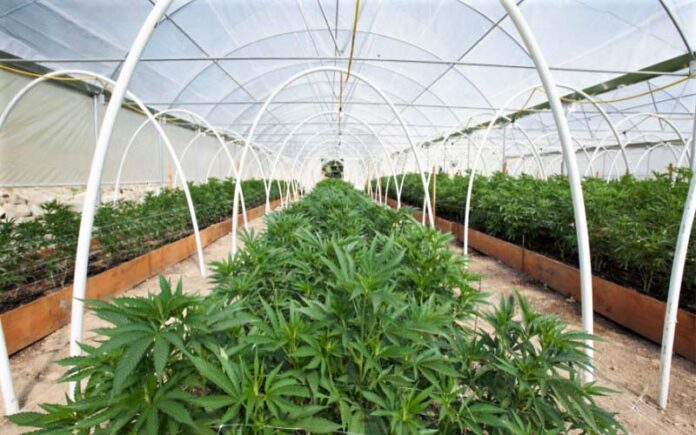New York’s first legal marijuana crop is growing and bound for stores this year
WARWICK – Shawn Bedard’s weed-dealing past used to be a barrier to employment, so much so that he says even a medical marijuana company declined to hire him due to his felony drug convictions.
But today, in a stark reversal made possible by New York’s legalization last year of pot for adult recreational use, Bedard presides over thousands of growing cannabis plants in a set of Orange County greenhouses that are helping nurture the state’s first legal marijuana crop. With full approval of the state that once prosecuted him, Bedard tends to rows of seed-grown Lemon Bubba and Singapore Sling with the devotion of a lifelong weed enthusiast and the hard-won expertise he has accumulated without formal training.
As he puts it, his rap sheet is now his resume.
“And that is what’s gotten me kind of here,” Bedard said during a tour on Tuesday of the Warwick greenhouses he oversees. “And that’s why I’m willing to take my small family and go anywhere in the country that can get me closer to being an accepted human being in our society. Or else I have to constantly fall back into the Grateful Dead parking lots and the places that will embrace me.”
Bedard is working with one of the 223 licensed hemp growers in New York who have gotten two-year cultivation licenses to inaugurate the state’s adult-use marijuana industry. The pungent plants now growing in fields and greenhouses from the tip of Long Island to Niagara Falls are set to be harvested in time to be sold before the end of the year in state-licensed dispensaries, after being packaged as dried flowers for smoking, pre-rolled joints or gummies and other consumable products.
In the seven-county Mid Hudson Valley region, 45 growers have been granted temporary cultivation licenses since April by the state Cannabis Control Board, a five-member panel of appointees that is steering the development of the new industry. That total includes 19 licenses in Orange County, 15 in Dutchess, seven in Ulster and four in Sullivan.
New York chose to steer the first flush of business to small, local hemp growers rather than the deep-pocketed, multi-state cannabis operators that already are growing and processing pot for medical use in New York. The state has 10 licensed medical marijuana companies, four of which are building large facilities or expanding operations in Orange and Ulster counties to prepare for the huge recreational market ahead. None has gotten a license yet to join the adult-use business.
Bedard is working in Warwick with Ed McCauley, a shop owner and former hemp grower who got a two-year cultivation license under the business name Grow Source LLC in May. McCauley says he grew hemp – a cannabis plant similar to marijuana – for about four years in the same warehouses where marijuana is now growing, stopping production around the end of 2019 after New York issued so many hemp licenses that the market became oversaturated and collapsed.
For the past two years, McCauley has owned a store near the Warwick greenhouses that sells gummies and other products made with cannabidiol, or CBD, a hemp-derived chemical that has the relaxing effect of pot without making the user high. He also operates Fusion CBD stores in Port Jervis and Lafayette, New Jersey.
McCauley said his Warwick shop is open seven days a week and earns half its revenue from gummies, which blend CBD and THC – the psychoactive compound in marijuana – and sell well with everyone from the young to the elderly. Any stigma once associated with CBD as a stoner drug has evaporated, he said.
“People need the CBD,” he said.
Ironically, McCauley’s stores won’t be able to sell the pot he’s growing. Unlike the state’s medical marijuana system, in which the same 10 companies grow and process weed and sell it in dispensaries, New York is dividing its adult-use industry to prevent monopolies and has prohibited growers from being sellers as well. In addition, it plans to reserve its first dispensary licenses for people with past convictions for selling pot – a corrective for decades of arrests that disproportionately impacted communities of color.
McCauley and Bedard, his director of cultivation, have about 4,800 marijuana plants growing so far, taking up about 11,000 square feet of the maximum 25,000 square feet New York is allowing each license holder to grow indoors under the two-year licenses (up to 43,560 square feet, or one acre, may be grown outside). About 20 different varieties are in development, with names like Live Long and Prosper, Durango O.G. and New York Sour Diesel – a popular strain that Bedard says originated in New York and “swept across the globe.”
“New Yorkers are really proud of their Sour,” Bedard said.
Bedard is one of only four workers staffing the greenhouse, which he said will have around nine workers when fully operational. Their initial harvest is expected in September, and a freezer is being installed to store the first matured plants for processing in case the state-licensed dispensaries haven’t opened yet to sell fresh buds. The greenhouses will operate year-round, with a harvest every eight weeks.
The next step for the state is setting up the dispensaries.
A look inside Warwick greenhouses housing thousands of growing cannabis plants that are part of New York’s first legal marijuana crop.
The Cannabis Control Board approved the regulations for dispensary licenses last week and plans to begin fielding license applications this summer. In the meantime, the state Dormitory Authority is scouting for as many as 150 vacant stores that it plans to lease, renovate and furnish to serve as dispensaries, an effort funded with up to $200 million in cannabis licensing fees and private investments.
The future dispensary operators will pay rent for those provided spaces. The state Office of Cannabis Management expects the stores to open by late fall.














